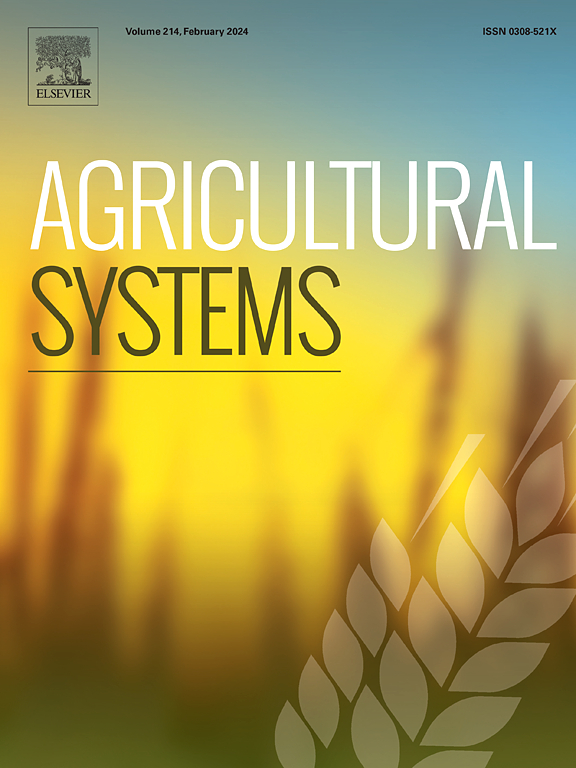Residue return and nitrogen application optimization can not balance crop yield increase and reducing emission in semi-arid region
IF 6.1
1区 农林科学
Q1 AGRICULTURE, MULTIDISCIPLINARY
引用次数: 0
Abstract
Context
Agricultural systems face the dual challenge of reducing greenhouse gas (GHG) emissions while ensuring food security in the context of future climate change and population growth. Farm practices, such as conservation agriculture practices and optimal nitrogen (N) fertilization, are widely promoted for their potential to sustain crop production and mitigate climate change impacts. However, the long-term effectiveness of these practices in balancing crop yields and GHG emissions under future climate scenarios remains uncertain.
Objective
This study investigates the impacts of residue retention and N fertilization strategies on crop yields, soil organic carbon (SOC) sequestration, and GHG emissions in the Riverina region of New South Wales, Australia, using the well-validated APSIM model under two Shared Socioeconomic Pathways (SSP245 and SSP585).
Methods
We used the APSIM model to evaluate three crop rotation systems—wheat-canola (WC), wheat-field pea-wheat-canola (WFWC), and wheat-wheat-canola (WWC)—under varying residue retention levels (10%, 50%, and 100%) and two N fertilization strategies (conventional and optimal). The conventional strategy was based on rainfall, while the optimal strategy adjusted N application according to in-season rainfall and soil moisture availability.
Results and conclusions
Our results indicate that the combined management practice of residue retention and optimized nitrogen application increases greenhouse gas intensity (GHGI) under future scenarios. Although this practice enhances short-term soil organic carbon (SOC) sequestration and boosts crop yield (a 22.1% increase in wheat yield under SSP245), it also significantly raises N₂O emissions (under SSP585, N₂O emissions were 13.7% higher than the baseline when 100% residue was retained). SOC peaked in the mid-21st century but declined thereafter due to accelerated decomposition driven by rising temperatures, leading to increased GHGI with higher residue retention rates. This suggests that the benefits of yield gains are offset by enhanced SOC decomposition and elevated N₂O emissions. Our findings highlight that the combination of residue retention and optimal N fertilization fails to achieve a long-term balance between crop yield and GHG emissions under climate change.
Significance
The findings underscore the need for integrated management strategies that consider both agronomic and environmental outcomes, including the potential for carbon credits and reduced N inputs, to sustainably address the dual challenges of food security and climate change mitigation.

在半干旱区,秸秆还田和氮肥优化不能平衡作物增产和减排
在未来气候变化和人口增长的背景下,农业系统面临着减少温室气体排放和确保粮食安全的双重挑战。农业实践,如保护性农业实践和最佳氮肥施肥,因其维持作物生产和减轻气候变化影响的潜力而得到广泛推广。然而,在未来气候情景下,这些做法在平衡作物产量和温室气体排放方面的长期有效性仍不确定。目的研究在两种共享社会经济路径(SSP245和SSP585)下,不同施肥策略对澳大利亚新南威尔士州Riverina地区作物产量、土壤有机碳(SOC)固存和温室气体排放的影响。方法采用APSIM模型对小麦-菜籽油(WC)、麦田-豌豆-小麦-菜籽油(WFWC)和小麦-小麦-菜籽油(WWC) 3种作物轮作系统在不同残留物保留水平(10%、50%和100%)和两种氮肥施肥策略(常规和最佳)下进行了评价。传统策略是基于降雨量,而最优策略是根据当季降雨量和土壤水分有效性来调整施氮量。结果与结论sour结果表明,在未来情景下,秸秆保留与优化氮肥施用相结合的管理措施增加了温室气体强度(GHGI)。虽然这种做法增加了短期土壤有机碳(SOC)的固存,提高了作物产量(SSP245下小麦产量增加22.1%),但也显著增加了N₂O排放量(在SSP585下,N₂O排放量比保留100%残留物的基线高出13.7%)。有机碳在21世纪中期达到峰值,但此后由于温度上升导致分解加速而下降,导致温室气体增加,残留物保留率更高。这表明,产量增加的好处被有机碳分解增强和二氧化碳排放增加所抵消。研究结果表明,在气候变化条件下,残茬保留与最优施氮组合不能实现作物产量与温室气体排放的长期平衡。研究结果强调,需要制定综合管理战略,考虑农学和环境成果,包括碳信用额和减少氮投入的潜力,以可持续地应对粮食安全和减缓气候变化的双重挑战。
本文章由计算机程序翻译,如有差异,请以英文原文为准。
求助全文
约1分钟内获得全文
求助全文
来源期刊

Agricultural Systems
农林科学-农业综合
CiteScore
13.30
自引率
7.60%
发文量
174
审稿时长
30 days
期刊介绍:
Agricultural Systems is an international journal that deals with interactions - among the components of agricultural systems, among hierarchical levels of agricultural systems, between agricultural and other land use systems, and between agricultural systems and their natural, social and economic environments.
The scope includes the development and application of systems analysis methodologies in the following areas:
Systems approaches in the sustainable intensification of agriculture; pathways for sustainable intensification; crop-livestock integration; farm-level resource allocation; quantification of benefits and trade-offs at farm to landscape levels; integrative, participatory and dynamic modelling approaches for qualitative and quantitative assessments of agricultural systems and decision making;
The interactions between agricultural and non-agricultural landscapes; the multiple services of agricultural systems; food security and the environment;
Global change and adaptation science; transformational adaptations as driven by changes in climate, policy, values and attitudes influencing the design of farming systems;
Development and application of farming systems design tools and methods for impact, scenario and case study analysis; managing the complexities of dynamic agricultural systems; innovation systems and multi stakeholder arrangements that support or promote change and (or) inform policy decisions.
 求助内容:
求助内容: 应助结果提醒方式:
应助结果提醒方式:


